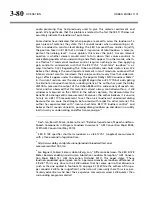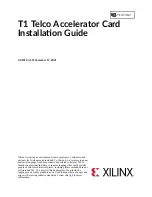
OPTIMOD-PC
OPERATION
3-79
BS.1770 and CBS measurements indicate that most of the data points are in a
±
1 dB/LK window.
The peak CBS readings fit within a
±
2 dB window. The BS.1770 readings also fit with-
in a
±
2 LK window except for four short intervals, which appear as low-probability
outliers in the left side of the histogram. These intervals correspond to dialog with-
out background music and in the author’s opinion illustrate a weakness in BS.1770-
2: based on our extensive listening tests, we have concluded that the meter does not
effectively lock onto the A/85 “anchor element” (almost entirely dialog in the test
material used to prepare this paper) and instead indicates that loudness increases
when dialog level is held constant while underscoring or effects are added to the
mix.
Problems with Low Peak-to-RMS Ratio Material
In the subjective testing to validate the BS.1770 meter, there were outliers as large
as 6 dB (i.e., the meter disagreed with human subjective perception by as much as 6
dB
.) The subjective testing to validate the CBS meter found outliers up to 3 dB, al-
though fewer items were used in this testing. We hypothesize that the fact that the
worst-case error of the BS.1770 meter was substantially larger than that of the CBS
meter is caused by the BS.1770’s meter’s not modeling loudness summation or the
loudness integration time constants of human hearing.
BS.1770-2 states: “It should be noted that while this algorithm has been shown to be
effective for use on audio programmes that are typical of broadcast content, the
algorithm is not, in general, suitable for use to estimate the subjective loudness of
pure tones.” We have noted that the meter tends to over-indicate the loudness of
program material that had been subject to large amounts of “artistic” dynamic
compression, as is often done for commercials and promotional material — in other
words, the meter over-indicates the loudness of program material having an unusu-
ally low peak-to-average ratio, which, at the limit, approaches the peak-to-average
ratio of a pure tone. We have encountered heated complaints by mixers
and pro-
ducers who stated that such material, when “matched” to the loudness of the sur-
rounding program material via the BS.1770 meter, is considerably quieter in subjec-
tive terms. In turn, this has constrained the ability of producers to specify the type of
8
In the first published version of the paper, we observed the similar dips in the
BS.1770-1 (ungated) loudness and hypothesized that they were caused by lack of
gating on silence and low-level material. For this reason, we were surprised that
BS.1770-2 gating made little difference in the measurements of this material.
9
Refer to the scatter plots in Figs. 11, 12, and 13 of the ITU-R BS.1770-2 standard.
10
For example: “I did a –24 [LKFS] piece for Fox that was wall to wall singing and
music for two minutes. Because of the overall loudness and continued full audio sig-
nal I had to bring it down and when it aired, it was 3 db too quiet even though it
matched the magic LKFS number. I have no problem using these meters or meeting
specs but they are faulty.”
—
“wheresmyfroggy,” AVID board, 3-28-2011
Summary of Contents for Optimod-PC 1101
Page 4: ......
Page 14: ......
Page 121: ...OPTIMOD PC OPERATION 3 1 Section 3 Operation Figure 3 1 The OPTIMOD PC Control Application...
Page 192: ...3 72 OPERATION ORBAN MODEL 1101...
Page 204: ......
Page 210: ......
Page 212: ...5 2 UNINSTALLATION ORBAN MODEL 1101...
Page 236: ......
















































